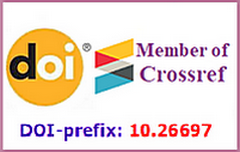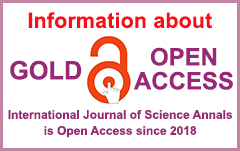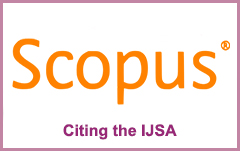| 1 Health Polytechnic, Jambi Ministry of Health, Indonesia 2 Health Polytechnic of the Ministry of Health Tanjung Karang, Indonesia 3 Jambi University, Indonesia |
Abstract
Background and Aim of Study: Developmental delays in children are still a serious problem in both developed and developing countries in the world. About 5-10% of children experience developmental delays. The potential to develop the current media in accordance with technological developments and advances in the use of technology-based platforms.
The aim of the study: to develop a growth and development assessment model to increase knowledge and skills in assessing the growth and development of toddlers and to analyze the implementation of the growth assessment guide model based on android applications.
Material and Methods: This type of research is design and development research with a mixed methods approach. The steps of development research are carried out using the ADDIE framework (Analysis, Design, Development, Implementation and Evaluation). In using this framework, designers and developers use analysis, design, development, implementation and evaluation as the main stages.
Results: The research product is the “GUVI_Tools” application which is an interactive multimedia-based learning media. The implementation of the application showed a significant increase in knowledge before and after using the application and the average application usage assessment was 4.8 (good category).
Conclusions: It is hoped that this development program can be used as a learning program and can develop learning media on other basic competencies and can be continued at the stage of testing the effectiveness of the learning process.
Keywords
assessment, growth and development, analysis, design, toddler
References
Al-Qeisi, K., Dennis, C., Alamanos, E., & Jayawardhena, C. (2014). Website design quality and usage behavior: Unified theory of acceptance and use of technology. Journal of Business Research, 67(11), 2282–2290. https://doi.org/10.1016/j.jbusres.2014.06.016
Arnett, J., Maynard, A. E., Brownlow, C., Chapin, L., & Machin, T. (2020). Child development a cultural approach. Pearson Australia. https://eprints.usq.edu.au/37393/
Bégin, F., Elder, L., Griffiths, M., Holschneider, S., Piwoz, E., Ruel-Bergeron, J., & Shekar, M. (2020). Promoting child growth and development in the sustainable development goals era: Is it time for new thinking? The Journal of Nutrition, 150(2), 192–194. https://doi.org/10.1093/jn/nxz244
Boyatzis, C., & Junn, E. N. (Eds.). (2020). Annual editions: Child growth and development (23rd ed.). McGraw-Hill. https://digitalcommons.bucknell.edu/books/76/
Clark, H. H. (1994). Managing problems in speaking. Speech Communication, 15(3–4), 243–250. https://doi.org/10.1016/0167-6393(94)90075-2
De Araújo, L. A., Veloso, C. F., de Campos Souza, M., de Azevedo, J. M. C., & Tarro, G. (2021). The potential impact of the COVID-19 pandemic on child growth and development: A systematic review. Jornal de Pediatria – Journal of Pediatrics, 97(4), 369–377. https://doi.org/10.1016/j.jped.2020.08.008
De Onis, M. (2017). Child growth and development. In S. de Pee, D. Taren, & M. Bloem (Eds.), Nutrition and Health in a Developing World (pp. 119–141). Humana Press. https://doi.org/10.1007/978-3-319-43739-2_6
Doyle, L., Brady, A.-M., & Byrne, G. (2009). An overview of mixed methods research. Journal of Research in Nursing, 14(2), 175–185. https://doi.org/10.1177/1744987108093962
Grantham-McGregor, S., Cheung, Y. B., Cueto, S., Glewwe, P., Richter, L., Strupp, B., & Group, I. C. D. S. (2007). Developmental potential in the first 5 years for children in developing countries. The Lancet, 369(9555), 60–70. https://doi.org/10.1016/S0140-6736(07)60032-4
Haleemunnissa, S., Didel, S., Swami, M. K., Singh, K., & Vyas, V. (2021). Children and COVID19: Understanding impact on the growth trajectory of an evolving generation. Children and Youth Services Review, 120, Article 105754. https://doi.org/10.1016/j.childyouth.2020.105754
Hernanda, S., & Yustanti, W. (2016). Rancang bangun aplikasi monitoring tumbuh kembang balita berbasis Android [Design and build a toddler growth monitoring application based on Android]. Jurnal Manajemen Informatika – Journal of Informatics Management, 6(1). https://jurnalmahasiswa.unesa.ac.id/index.php/11/article/viewFile/17270/15707 [in Indonesian]
Huang, W.-H. D., Hood, D. W., & Yoo, S. J. (2013). Gender divide and acceptance of collaborative Web 2.0 applications for learning in higher education. The Internet and Higher Education, 16, 57–65. https://doi.org/10.1016/j.iheduc.2012.02.001
Hyman, S. L., Levy, S. E., Myers, S. M., Kuo, D. Z., Apkon, S., Davidson, L. F., Ellerbeck, K. A., Foster, J. E. A., Noritz, G. H., & Leppert, M. O. (2020). Identification, evaluation, and management of children with autism spectrum disorder. Pediatrics, 145(1), e20193447. https://doi.org/10.1542/peds.2019-3447
Jeharsae, R., Sangthong, R., Wichaidit, W., & Chongsuvivatwong, V. (2013). Growth and development of children aged 1–5 years in low-intensity armed conflict areas in Southern Thailand: A community-based survey. Conflict and Health, 7, Article 8. https://doi.org/10.1186/1752-1505-7-8
Johnson, C. I., & Mayer, R. E. (2009). A testing effect with multimedia learning. Journal of Educational Psychology, 101(3), 621–629. https://doi.org/10.1037/a0015183
Julizal, Lukman, & Sunoto, I. (2019). Rancang bangun aplikasi sistem monitoring pertumbuhan anak sebagai alat deteksi pertumbuhan [Design and build a child growth monitoring system application as a growth detection tool]. Satuan Tulisan Riset Dan Inovasi Teknologi – Research and Technology Innovation Writing Unit, 4(1), 18–24. https://doi.org/10.30998/string.v4i1.3728 [in Indonesian]
Kozma, R. B. (1994). A reply: Media and methods. Educational Technology Research and Development, 42, 11–14. https://link.springer.com/article/10.1007%2FBF02298091
Lee, H.-Y., Cherng, R.-J., & Lin, C.-H. (2004). Development of a virtual reality environment for somatosensory and perceptual stimulation in the balance assessment of children. Computers in Biology and Medicine, 34(8), 719–733. https://doi.org/10.1016/j.compbiomed.2003.10.004
Lejarraga, H., Menendez, A. M., Menzano, E., Guerra, L., Biancato, S., Pianelli, P., Del Pino, M., Fattore, M. J., & Contreras, M. M. (2008). Screening for developmental problems at primary care level: A field programme in San Isidro, Argentina. Paediatric and Perinatal Epidemiology, 22(2), 180–187. https://doi.org/10.1111/j.1365-3016.2007.00897.x
Levasseur, D. G., & Sawyer, J. K. (2006). Pedagogy meets PowerPoint: A research review of the effects of computer-generated slides in the classroom. The Review of Communication, 6(1-2), 101–123. https://doi.org/10.1080/15358590600763383
Lindsay, B. R. (2011). Social media and disasters: Current uses, future options, and policy considerations (CRS Report for Congress R41987). https://mirror.explodie.org/CRS-Report-SocialMediaDisasters-Lindsay-SEP2011.pdf
Lipkin, P. H., Macias, M. M., Norwood, K. W., Brei, T. J., Davidson, L. F., Davis, B. E., Ellerbeck, K. A., Houtrow, A. J., Hyman, S. L., & Kuo, D. Z. (2020). Promoting optimal development: Identifying infants and young children with developmental disorders through developmental surveillance and screening. Pediatrics, 145(1), e20193449. https://doi.org/10.1542/peds.2019-3449
McDevitt, T. M., & Ormrod, J. E., (2020). Child development and education (7th ed.). Pearson Education. https://www.pearsonhighered.com/assets/preface/0/1/3/4/0134806778.pdf
Mohammadi, S., Carey, D., Dick, F., Diedrichsen, J., Sereno, M. I., Reisert, M., Callaghan, M. F., & Weiskopf, N. (2015). Whole-brain in-vivo measurements of the axonal g-ratio in a group of 37 healthy volunteers. Frontiers in Neuroscience, 9, Article 441. https://doi.org/10.3389/fnins.2015.00441
O’Cathain, A., Murphy, E., & Nicholl, J. (2007). Why, and how, mixed methods research is undertaken in health services research in England: A mixed methods study. BMC Health Services Research, 7, Article 85. https://doi.org/10.1186/1472-6963-7-85
Park, J. H. (2020). Smartphone use patterns of smartphone-dependent children. Child Health Nursing Research, 26(1), 47–54. https://doi.org/10.4094/chnr.2020.26.1.47
Radgohar, H., Vahdat-Nejad, H., & Rezaie, S. M. (2020). Infant’s growth and nutrition monitoring system. SN Applied Sciences, 2(8), 1477. https://doi.org/10.1007/s42452-020-03264-2
Roux, A. M., Herrera, P., Wold, C. M., Dunkle, M. C., Glascoe, F. P., & Shattuck, P. T. (2012). Developmental and autism screening through 2-1-1: reaching underserved families. American Journal of Preventive Medicine, 43(6), S457–S463. https://doi.org/10.1016/j.amepre.2012.08.011
Rusdi, M. (2018). Penelitian desain dan pengembangan kependidikan [Educational design and development research]. PT.RajaGrafindo Persada. https://fkip.unri.ac.id/wp-content/uploads/2019/06/Bahan-Presentasi-R-D-min.pdf [in Indonesian]
Sanitasari, R. D., Andreswari, D., & Purwandari, E. P. (2017). Sistem monitoring tumbuh kembang anak usia 0-5 tahun berbasis Android [Android based growth monitoring system for 0-5 years old children]. Jurnal Rekursif – Recursive Journal, 5(1). https://ejournal.unib.ac.id/index.php/rekursif/article/view/2518/1362 [in Indonesian]
Saurina, N. (2016). Aplikasi deteksi dini tumbuh kembang anak usia nol hingga enam tahun berbasis Android [Applications for early detection of growth and development of children age zero to six years based on Android.]. Jurnal Buana Informatika – Journal of Buana Informatics, 7(1), 65–74. https://doi.org/10.24002/jbi.v7i1.485 [in Indonesian]
Stein, A., Pearson, R. M., Goodman, S. H., Rapa, E., Rahman, A., McCallum, M., Howard, L. M., & Pariante, C. M. (2014). Effects of perinatal mental disorders on the fetus and child. The Lancet, 384(9956), 1800–1819. https://doi.org/10.1016/S0140-6736(14)61277-0
Toldo, M., Varishthananda, S., Einspieler, C., Tripathi, N., Singh, A., Verma, S. K., Vishwakarma, K., Zhang, D., Dwivedi, A., & Gupta, R. (2020). Enhancing early detection of neurological and developmental disorders and provision of intervention in low-resource settings in Uttar Pradesh, India: Study protocol of the GANESH programme. BMJ Open, 10(11), e037335. https://doi.org/10.1136/bmjopen-2020-037335
Urlacher, S. S. (2021). Child growth and development: New insights from evolutionary energetics. Annals of Human Biology, 48(5), 371–373. https://doi.org/10.1080/03014460.2021.1974090
Wang, L., Liang, W., Zhang, S., Jonsson, L., Li, M., Yu, C., Sun, Y., Ma, Q., Bai, Y., & Abbey, C. (2019). Are infant/toddler developmental delays a problem across rural China? Journal of Comparative Economics, 47(2), 458–469. https://doi.org/10.1016/j.jce.2019.02.003
Wang, Z., Devine, R. T., Wong, K. K., & Hughes, C. (2016). Theory of mind and executive function during middle childhood across cultures. Journal of Experimental Child Psychology, 149, 6–22. https://doi.org/10.1016/j.jecp.2015.09.028
Webster‐Stratton, C., & Herman, K. C. (2010). Disseminating incredible years series early‐intervention programs: Integrating and sustaining services between school and home. Psychology in the Schools, 47(1), 36–54. https://doi.org/10.1002/pits.20450
White, K. R. (2006). Early intervention for children with permanent hearing loss: Finishing the EHDI revolution. The Volta Review, 106(3), 237–258. https://psycnet.apa.org/record/2007-14930-001
Wijayanto, B. (2012). Prototype aplikasi tumbuh kembang balita berbasiskan Android untuk kader Posyandu di pedesaan [Prototype of Android-based toddler growth and development application for Paysandú cadres in rural areas]. Seminar Nasional Aplikasi Teknologi Informasi – National Seminar on Information Technology Application, 15–16, C11–C15. https://journal.uii.ac.id/Snati/article/view/2891 [in Indonesian]
Handayani Gusti Lestari (Corresponding Author) – https://orcid.org/0000-0001-5529-8420;
Dewi Vivianti – https://orcid.org/0000-0003-3073-7516; M.Kep, Associate Professor, Lecturer, Health Polytechnic, Jambi Ministry of Health, Jambi, Indonesia.
Elrifda Solha – https://orcid.org/0000-0002-1679-2116; Dr, Associate Professor, Lecturer, Health Polytechnic, Jambi Ministry of Health, Jambi, Indonesia.
Rihiantoro Tori – https://orcid.org/0000-0001-7278-8106; M.Kep, Associate Professor, Lecturer, Health Polytechnic of the Ministry of Health Tanjung Karang, Jambi, Indonesia.
Rusdi Muhammad – https://orcid.org/0000-0003-1075-6023; Professor, Lecturer, Teacher and Education Faculty, Jambi University, Indonesia.
Haryanto – https://orcid.org/0000-0002-8322-2922; Dr, Lecturer, Teacher and Education Faculty, Jambi University, Indonesia.
| |
APA
Handayani, G. L., Dewi, V., Elrifda, S., Rihiantoro, T., Rusdi, M., & Haryanto. (2021). Development of educational media in assessing the growth and development of toddlers. International Journal of Science Annals, 4(2), 9–19. https://doi.org/10.26697/ijsa.2021.2.2
Harvard
Handayani, G. L., Dewi, V., Elrifda, S., Rihiantoro, T., Rusdi, M., & Haryanto., 2021. "Development of educational media in assessing the growth and development of toddlers". International Journal of Science Annals, [online] 4(2), pp. 9-19. viewed 25 December 2021, https://culturehealth.org/ijsa_archive/ijsa.2021.2.2.pdfVancouver
Handayani G. L., Dewi, V., Elrifda S., Rihiantoro T., Rusdi M., & Haryanto. Development of educational media in assessing the growth and development of toddlers. International Journal of Science Annals [Internet]. 2021 [cited 25 December 2021]; 4(2): 9-19. Available from: https://culturehealth.org/ijsa_archive/ijsa.2021.2.2.pdf https://doi.org/10.26697/ijsa.2021.2.2












